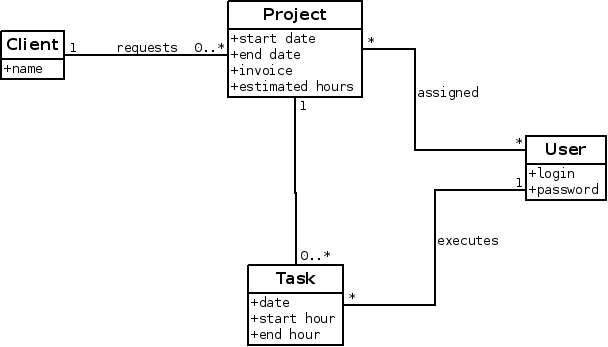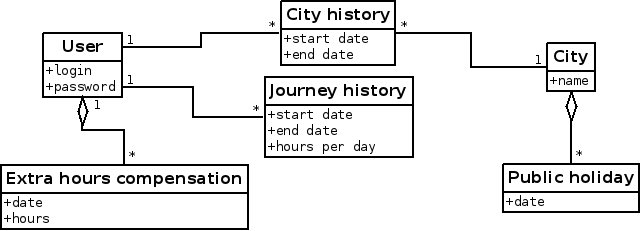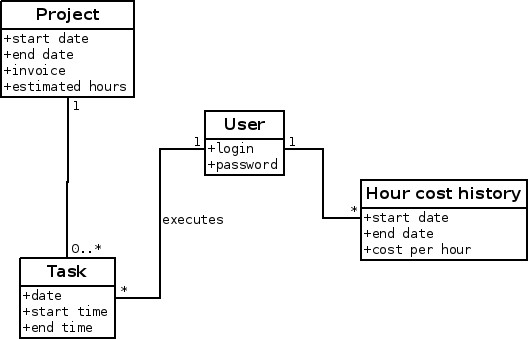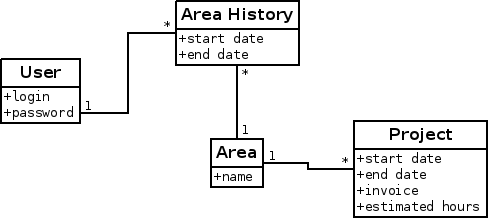Overview
PhpReport is an open source web application for time tracking, focused both on project control and working day management. It tries to provide useful data for workers and managers about the way time is devoted to projects.
Data model for time tracking
The core purpose of PhpReport is being able to track the time devoted to work by members of an organization, and which part of that time is devoted to every running project. The core of the time tracking revolves around these four entities:
- Task entity represents a task performed by a user in a date, with a determinate length stored in its start and end time.
- User entity represents a user of the system, who is meant to be a member of the organization being tracked. Every member is supposed to be working and tracking their hours in the system.
- Project entity represents a project, a common goal for a set of tasks.
- Client entity represents an organization who requests a project.

The relations stablished between them are the following:
- Every task belongs to one user; users can execute any number of tasks.
- Users are assigned to projects, with no constraints of number of users or projects.
- Every task belongs to one project; projects can have any number of tasks.
- Clients request projects; a client can request more than one project but each project is requested only by one client.
Data model for working day management
PhpReport can calculate the number of hours users are supposed to work and track the balance of extra or undone hours. It can also take into account public holidays to do that calculation. These are the new entities introduced with this purpose:
- City entity represents a city, because public holidays are usually set at city level.
- Public holiday entity represents one public holiday which belongs to one city.
- City history entity represents the history of cities to which a user has belonged, between two dates.
- Journey history entity represents the number of hours a user is supposed to work per working day between two dates. PhpReport considers there are five working days per week, from Monday to Friday, excepting public holidays.
- Extra hour compensations entity represents a moment in time where the calculation of extra hours for a particular user is reset to a new figure, ignoring all the previous history.

Relations between these entities:
- A user can have any number of associated city history entities, as long as the time periods of these history entities don't overlap.
- In the same way, a user can have any number of associated journey history entities, fulfilling the same condition about overlapping.
- One city history entity can only be related to one city, as a consequence a user can't be member of multiple cities at the same time.
- Finally, a city can have any number of public holiday entities. One public holiday entity can only be related with one city, so if the same date is a holiday in different cities there must be two entities with the same date but different relations.
- A user can be associated with any number of extra hours compensation entities.
Data model for project cost management
PhpReport can estimate the cost, deviation, benefit and other economical data of your projects. The related entities are:
- User, Project and Task entities, already introduced.
- Hour cost history entity, it represents the history of the cost per hour for a user in different time periods.

This is the explanation of the relations stablished between these entities:
- A user can have any number of associated hour cost history entities, as long as the time periods don't overlap.
- The application can know the number of hours devoted to a project by every user, through the relation with task entity and its relation with project entity. Using the date of the tasks and the relation with hour cost history, the cost of every work hour can be calculated.
Data model for organization structure
PhpReport structures the organization in areas, to which users and projects belong. This is a breakdown of the related entities:
- User and Project entities, already introduced.
- Area entity, it represent an area of interest inside the organization.
- Area history entity, it represents the history of the membership of a user to different areas.

Relations between these entities:
- A user can have any number of associated area history entities, as long as the time periods don't overlap.
- One area history entity can only be related to one area, as a consequence a user can't be member of multiple areas at the same time.
- Finally, a project belongs to only one area, while an area can have many projects.
Data model for holiday management
PhpReport can also calculate the number of holiday hours corresponding to every worker according to their contract and journey conditions. Holidays are treated as tasks belonging to a specific project called "Holidays". Users taking one day of holidays should fill a task specifying that project, and with a number of hours equal to the length of their working day (which is 8 hours by default).
The entities involved in this process are:
- A specific project called 'Holidays'.
- The Task entity, in this case represents used holidays.
- A configuration parameter called
YEARLY_HOLIDAY_HOURS, it indicates the number of holiday hours corresponding to one person in a year having a journey of 8 hours per day. The default value is 184 hours, which corresponds to 23 holidays per year. The application will adjust this value according to the specific case of every user, as specified below. - Journey history entity is also involved in this calculation,
adjusting the value of
YEARLY_HOLIDAY_HOURSto the situation of every user. E.g. a user working 4 hours per day would have 92 hours, and a person working from January to June would have 92 hours too, assuming the default configuration.